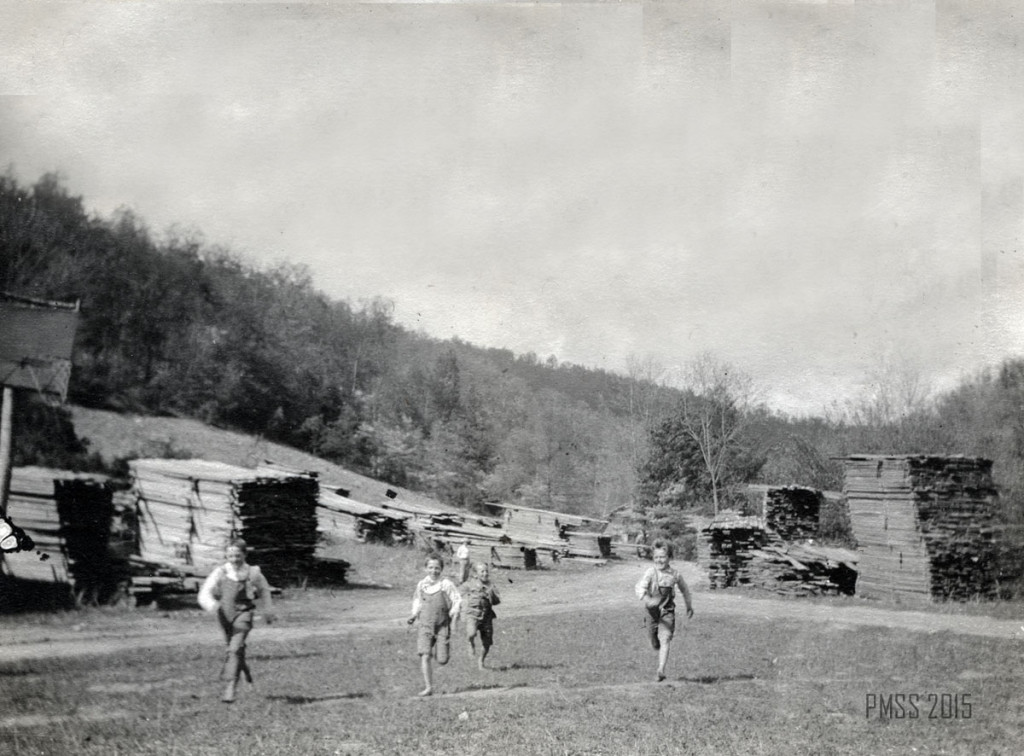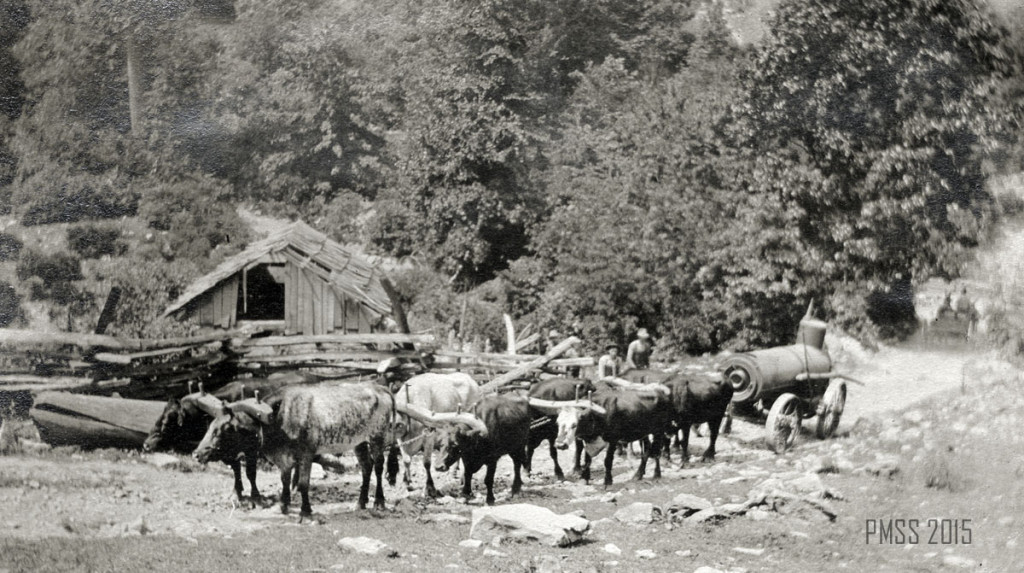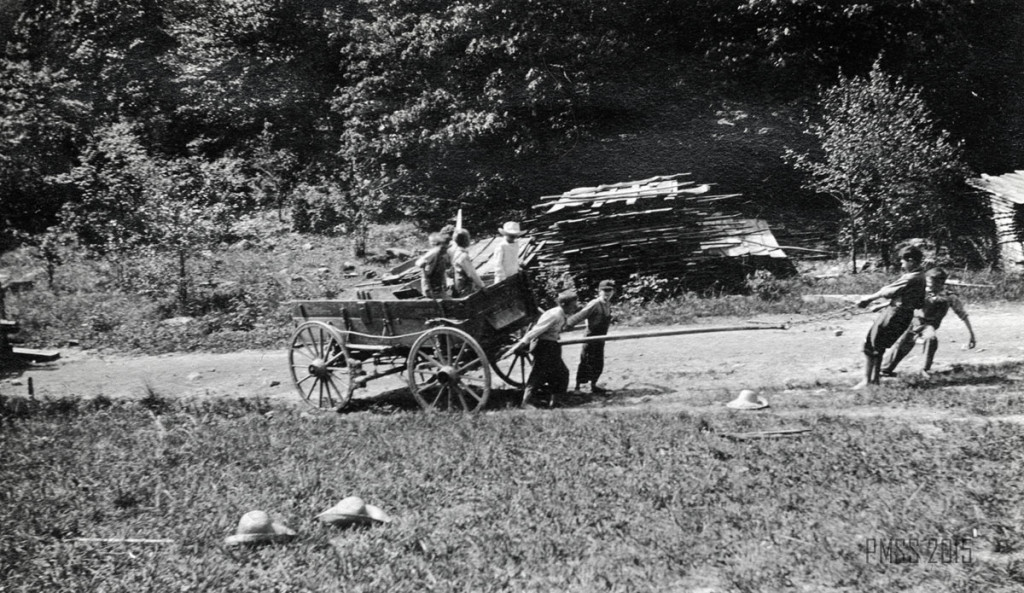Pine Mountain Settlement School
Series 10: BUILT ENVIRONMENT
Sawmill
Built 1913 – 1914

Sawmill. P. Roettinger Album. “A Race.” Four boys running past stacks of lumber waiting to dry for campus construction, c. 1914-15. [roe_027b.jpg]
TAGS: sawmills, logging, lumber, wood, buildings, built environment, forestry, saws, milling wood, Horace McSwain, Fitzhugh, Katherine Pettit, Ethel de Long, Frick Company, Waynesboro PA, boilers, freight rates, Dillon KY, Laden KY, railroads, oxen, timber, Incline railway, tramways
SAWMILL
SAWMILL: Installation
When the co-directors, Katherine Pettit and Ethel de Long began overseeing the construction of the buildings for the new Pine Mountain Settlement School, they wisely realized that it would be more cost-effective to set up their own temporary sawmill on the campus. To do so required a huge effort to assemble the necessary equipment and the necessity of hiring reliable workers to operate the sawmill.
PMSS co-director Ethel de Long wrote in a report to the Board of Trustees, dated May 24, 1913:
We are about to place an order with the Frick Company of Waynesboro, Pennsylvania, for a saw-mlll. The only saw-mill anywhere around here is so dilapidated as to be almost useless, and we feel that the best economy for us is to have a mill of our own, since we shall probably be needing it for several years. The Frick people are giving us splendid discounts, but we shall be under very heavy expense for hauling, since we must pay seventy cents a hundred for hauling for everything that comes to us from the outside world.
And how right she was. The transportation of the large boiler for the mill became an adventure as it was moved from the Dillon or Laden station on the South side of the mountain after it arrived by train. Up and across Pine Mountain, before the Laden Trail road was built, mules and men pushed and pulled the cumbersome equipment. The men entrusted with its safe journey to Pine Mountain knew how valuable the piece of equipment would be to the creation of the School, but it was one of the most demanding tasks any had seen in their many journeys across the mountain. Several times as they made their way on the mountain, especially on the steep North side, they held their breath as the large boiler teetered and sometimes tottered on the edge of disaster.
Fitzhugh [Lane?], a local man who had experience with sawmills had been secured by Katherine Pettit and Ethel de Long from a job in Jenkins to run the sawmill and to oversee its installation. His position was a temporary one to assist the School in getting the new mill up and running. He was aided by Horace McSwain, Pine Mountain’s first farmer, who learned the skill of the mill’s operation and soon became supervisor of the mill crew. Ethel de Long notes in her May 24, 1913, letter to the board and friends of the School that
Fitzhugh will be able to run the saw-mill when it comes, and is valuable to us in many ways. He left a very good position at Jenkins, Kentucky, to come here to help us.
On August 4, 1913, Miss Pettit writes to friends and the board:
Miss [Ethel] de Long is making an effort to get the money for the timber that it still seems to us our School should own. We have a man now who is acquainted with the different classes of trees going over the land estimating the lumber that can be cut. He is finding much more and valuable timber than we expected. The people who own the Incline road across Pine Mountain seven miles from her are extending the tramway to within two miles of us, to take out all of the merchantable trees. We shall probably never have another such an opportunity as this again.
All during July I felt quite sure that I could begin this letter by saying that the new sawmill was on the ground sawing up the great piles of logs that the people here have cut and given to the School, Today finds us with part of it on our lumber yard, part at Incline, and part at Ross Point. Fitzhugh has gone today to take care of the engine as it comes across Pine Mountain on the Incline [rail] road. The effort to get it here is a difficult one. The men who brought the boiler in with eight oxen said to me “This is a safe and easy way compared to that risky Incline road across Pine Mountain. Some places the small steel rails are broken or slipped apart at the end and a piece of wood is supplied for a rail. Many places the cross ties are rotten under the little rails. Everybody was careful and came so slowly that we had only one wreck.” The well on top of Pine Mountain which furnishes the water to run this road [Incline] is often dry and they have to wait between trips for the water to run in. Mr. McSwain, our farmer went down and suggested that they clean the mud out of the well which helped some.
It was a picturesque sight to see the eight yoke of oxen coming up the narrow, rough, short-curved road to the school grounds with the boiler. The two drivers managed it well. Three other men were behind to hold the boom pole to keep it from turning over the banks. “
Fitzhugh apparently did not last long and by 1914 Miss de Long writes to friends and the board that the farmer, Horace McSwain, was put in charge of the mill. She says of McSwain and the sawmill:
He has had to be at the sawmill all the time, largely because he has not known what minute one of his hands would have to escape to the woods. You see this is not a conventional community and many of our best workers have indictments against them, for shooting, fighting, or even being mixed up in a murder case. Since this is the month when court convenes the men with indictments against them are all afraid the sheriffs may be after them….
SAWMILL In Operation
Finally the mill was in place, logs were beginning to be cut, and boards piled high on the School grounds to meet the carpentry needs of construction. In early 1914 the “Dear Friend” letter reveals that the “splendid mill” was in place and operating.
When we have not so much as a plank for a tiny bookshelf in this country of wonderful trees but not sawmills, we think of our splendid mill, given us by a friend who well understood our needs, waiting and ready for the great chestnut and poplar logs that are being cut from the School forest. ….
By November 14, 1914, Ethel de Long writes in a Letter to Friends:
For a year and a half we have cleared forest, cleaned out streams, ditched marsh land, hewn logs, made roads, built houses, planted fruit trees, and ‘laid by’ crops. At last we have a roof over our heads and a harvest gathered; we can take a breath to write you of the school in the wilderness!
| Title | Sawmill |
| Identifier | Saw Mill ; Saw-Mill ; |
| Creator | Pine Mountain Settlement School, Pine Mountain, KY. |
| Alt. Creator | Ann Angel Eberhardt ; Helen Hayes Wykle ; |
| Subject | sawmills, logging, lumber, wood, buildings, built environment, forestry, saws, milling wood, Horace McSwain, Fitzhugh, Katherine Pettit, Ethel de Long, Frick Company, Waynesboro PA, boilers, freight rates, Dillon KY, Laden KY, railroads, oxen, timber, Incline railway, tramways |
| Subject LCSH : | Sawmills — Kentucky. Logging — Kentucky. Logging. Sawmills. Kentucky — Sawmills Education — Appalachian Region Pine Mountain Settlement School — History Rural schools — Appalachian Region, Southern Rural schools — Kentucky — History Schools — Appalachian Region Farms — Appalachian Region Pettit, Katherine Zande, Ethel de Long |
| Date original | n/a |
| Date digital | 2012-06-30 ; 2015-03-27 ; |
| Publisher | Pine Mountain Settlement School, Pine Mountain, KY. |
| Contributor | n/a |
| Type | Collections ; text ; image ; |
| Format | Original and copies of documents and correspondence in file folders in filing cabinet. |
| Source | PMSS Series 10: BUILT ENVIRONMENT (Physical Plant) |
| Language | English |
| Relation |
Pine Mountain Settlement School Collections, Series 10: BUILT ENVIRONMENT Kentucky Virtual Library collections <http://www.kyvl.org/> |
| Coverage temporal & spatial | 1913 – 1950s ; Pine Mountain Settlement School, KY ; Southern Appalachians ; Waynesboro, PA ; Dillon, KY ; Laden KY ; |
| Rights | Any display, publication, or public use must credit Pine Mountain Settlement School. Copyright retained by the creators of certain items in the collection, or their descendants, as stipulated by United States copyright law. |
| Donor | n/a |
| Description | Note from Miss Pettit:, early 1913: “We are about to place an order with the Frick Company of Waynesboro, Pennsylvania, for a saw-mill. The only saw-mill anywhere around here is so dilapidated as to be almost useless, and we feel that the best economy for us is to have a mill of our own, since we shall probably be needing it for several years. The Frick people are giving us splendid discounts, but we shall be under very heavy expense for hauling, since we must pay seventy cents a hundred for hauling for everything that comes to us from the outside world.” |
| Acquisition | n/a |
| Citation | Sawmill.” Series 10: BUILT ENVIRONMENT. Pine Mountain Settlement School Institutional Papers. Pine Mountain Settlement School, Pine Mountain, KY. Internet resource. |
| Processed by | Helen Wykle 2012-06-30 ; 2015-03-27 ; Ann Angel Eberhardt ; |
| Last updated | 2012-06-30 hhw ; 2015-03-27 hhw ; 2017-0201 hhw ; 2023-04-07 aae ; 2025-06-13 aae ; |
Return To:
BUILT ENVIRONMENT Guide



